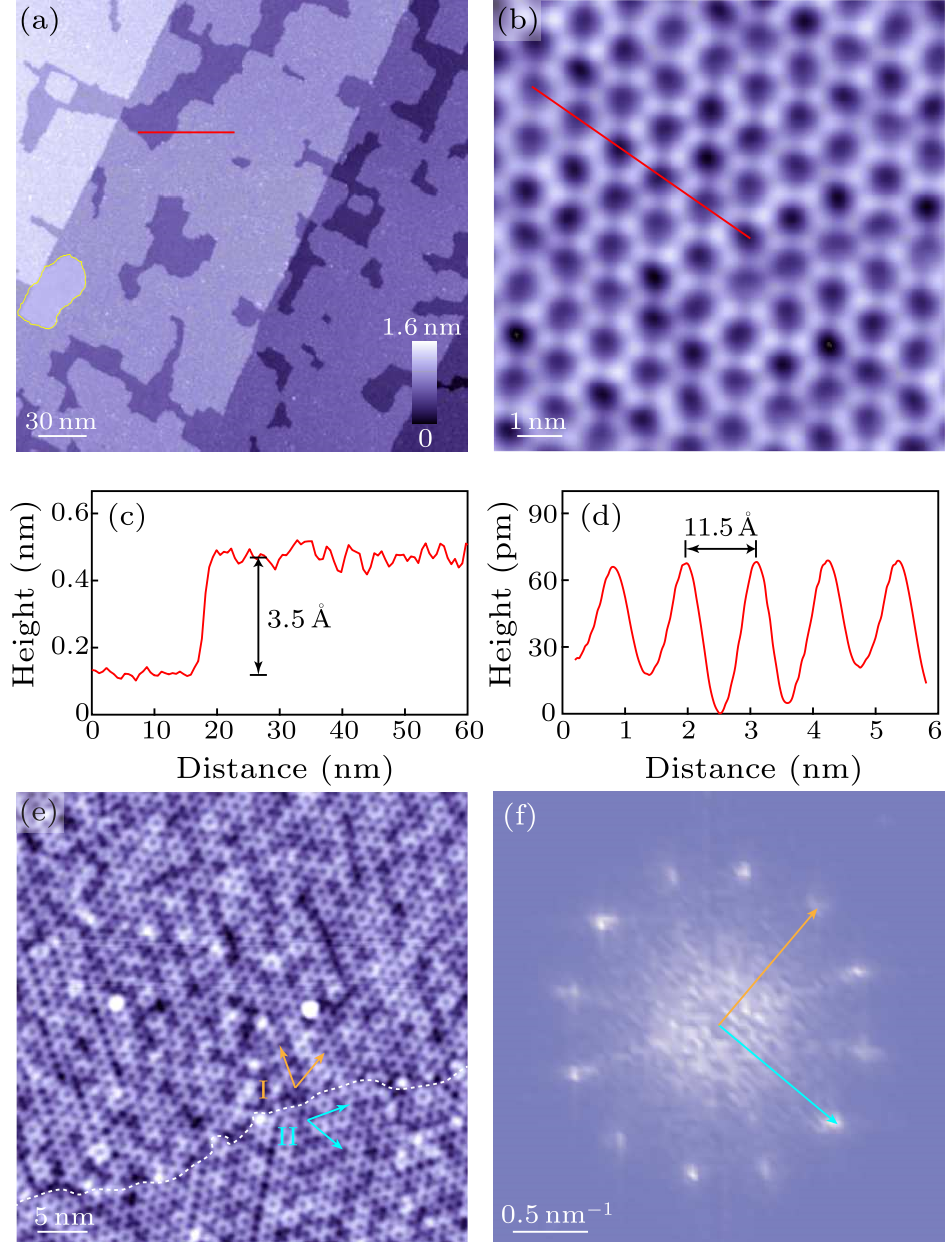
Fig. 1. (a) Representative STM topography ($280{\,\rm nm} \times 280{\,\rm nm}$, $V = 3.0$ V, $I = 50$ pA) of epitaxial honeycomb-structured Fe$_{2}$Te films at 330 ℃ under Te-limited growth conditions. A small patch of hexagonal $\alpha$-FeTe phase is encircled in yellow. (b) High-resolution STM image ($10{\,\rm nm} \times 10{\,\rm nm}$, $V = 0.3$ V, $I = 100$ pA) displaying the honeycomb lattice of Fe$_{2}$Te. [(c), (d)] Line profiles taken along the red lines in (a) and (b), respectively, from which the out-of-plane and in-plane lattice parameters can be readily extracted. (e) STM topography ($45{\,\rm nm} \times 45{\,\rm nm}$, $V = 2.0$ V, $I = 100$ pA) of Fe$_{2}$Te films showing two distinct domains (I and II), which are rotated by 30$^{\circ}$ with each other (see the colored arrows). (f) Fourier transform image of STM topography in (e). The orange and cyan arrows with different FFT intensities distinguish the two rotational domains in (e).
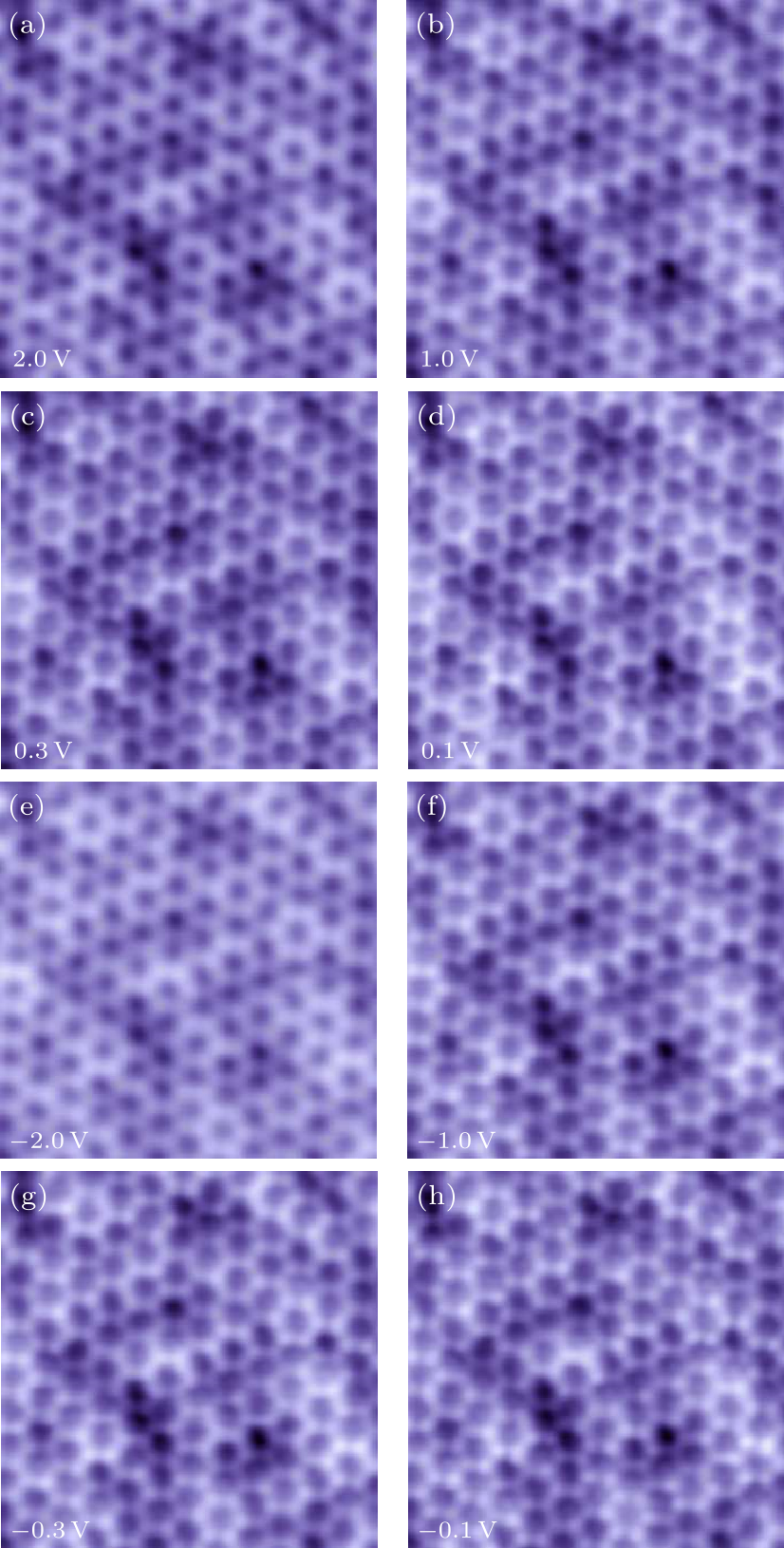
Fig. 2. (a)–(h) Atomically resolved STM topographies ($12{\,\rm nm} \times 12{\,\rm nm}$, $I = 100$ pA) of $h$-Fe$_{2}$Te under various sample biases as indicated.
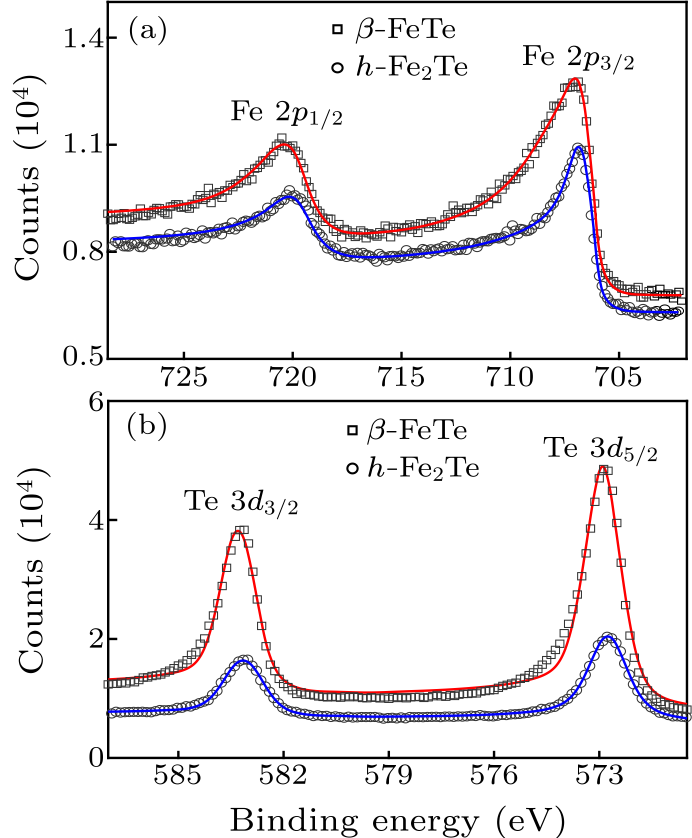
Fig. 3. In-situ XPS spectra of tetragonal $\beta$-FeTe and honeycomb Fe$_{2}$Te in (a) Fe $2p$ and (b) Te $3d$ core level regions. The asymmetrical Voigt function, denoted by the solid lines, nicely fits the experimental data (empty squares and circles).
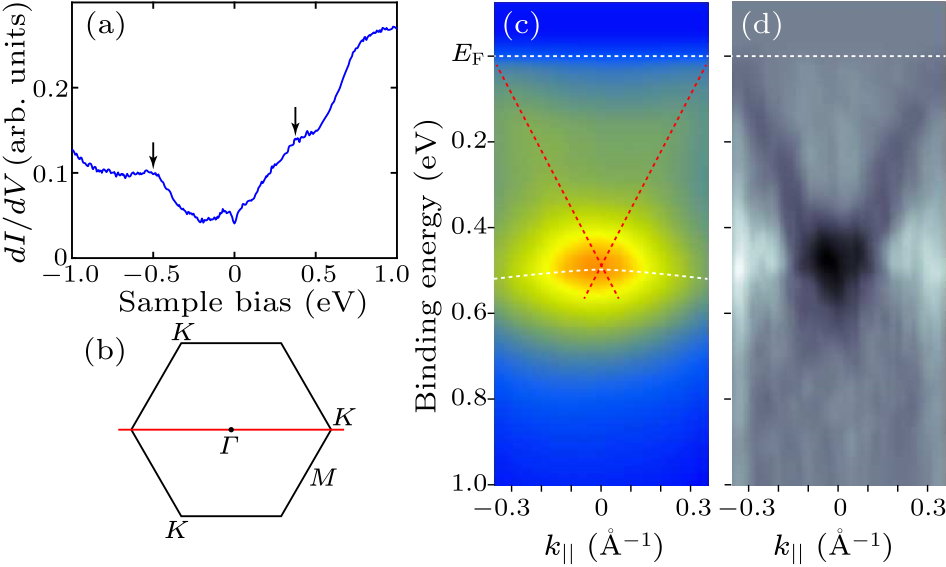
Fig. 4. (a) Spatially averaged differential conductance $dI/dV$ spectrum on $h$-Fe$_{2}$Te, showing electron-like electronic states around $E_{\rm F}$. The down arrows mark the electronic DOS humps at $-0.5$ eV and 0.4 eV. Tunneling junction is stabilized at $V = 1.0$ V and $I = 100$ pA. (b) Illustration of the Brillouin zone of the honeycomb lattice. (c) ARPES intensity map and (d) its differential image of Fe$_{2}$Te films taken along the $K$–$\varGamma$–$K$ direction, as marked by the red solid line in (b). The red dashed lines schematically denote the band dispersion near the point, while the white one marks an extremely flat band around $-0.5$ eV.
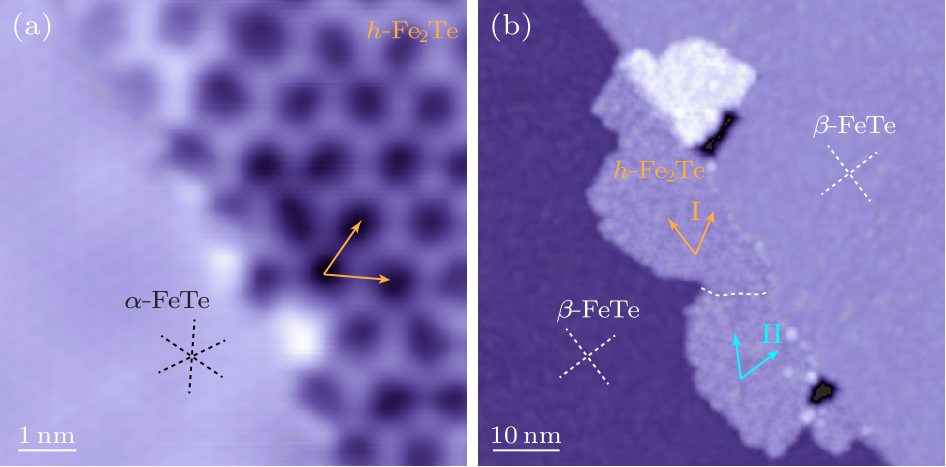
Fig. 5. (a) Atomically resolved STM topography ($8{\,\rm nm} \times 8{\,\rm nm}$, $V = 0.3$ V, $I = 200$ pA) across a phase boundary between the co-existing $h$-Fe$_2$Te and $\alpha$-FeTe films. (b) STM topography ($70{\,\rm nm} \times 70{\,\rm nm}$, $V = 1.0$ V, $I = 100$ pA) of $h$-Fe$_2$Te grown on a pre-existing $\beta$-FeTe film supported by the SrTiO$_3$ substrate. The colored arrows, black and white dashes are aligned along the crystal directions of $h$-Fe$_2$Te, $\alpha$-FeTe and $\beta$-FeTe, respectively.
| [1] | Novoselov K S, Geim A K, Morozov S V et al. 2004 Science 306 666 | Electric Field Effect in Atomically Thin Carbon Films
| [2] | Geim A K and Novoselov K S 2007 Nat. Mater. 6 183 | The rise of graphene
| [3] | Novoselov K S, Geim A K, Morozov S V et al. 2005 Nature 438 197 | Two-dimensional gas of massless Dirac fermions in graphene
| [4] | Liu H, Neal A T, Zhu Z et al. 2014 ACS Nano 8 4033 | Phosphorene: An Unexplored 2D Semiconductor with a High Hole Mobility
| [5] | Vogt P, De Padova P, Quaresima C et al. 2012 Phys. Rev. Lett. 108 155501 | Silicene: Compelling Experimental Evidence for Graphenelike Two-Dimensional Silicon
| [6] | Bianco E, Butler S, Jiang S et al. 2013 ACS Nano 7 4414 | Stability and Exfoliation of Germanane: A Germanium Graphane Analogue
| [7] | Zhu F F, Chen W J, Xu Y et al. 2015 Nat. Mater. 14 1020 | Epitaxial growth of two-dimensional stanene
| [8] | Deng J L, Xia B Y, Ma X C et al. 2018 Nat. Mater. 17 1081 | Epitaxial growth of ultraflat stanene with topological band inversion
| [9] | Li L L, Yu Y J, Ye G J et al. 2014 Nat. Nanotechnol. 9 372 | Black phosphorus field-effect transistors
| [10] | Vishnoi P, Mazumder M, Pati S K et al. 2018 New J. Chem. 42 14091 | Arsenene nanosheets and nanodots
| [11] | Ares P, Aguilar-Galindo F, Rodríguez-San-Miguel D et al. 2016 Adv. Mater. 28 6332 | Mechanical Isolation of Highly Stable Antimonene under Ambient Conditions
| [12] | Reis F, Li G, Dudy L et al. 2017 Science 357 287 | Bismuthene on a SiC substrate: A candidate for a high-temperature quantum spin Hall material
| [13] | Wang Y, Qiu G, Wang R X et al. 2018 Nat. Electron. 1 228 | Field-effect transistors made from solution-grown two-dimensional tellurene
| [14] | Xu Y, Yan B, Zhang H J et al. 2013 Phys. Rev. Lett. 111 136804 | Large-Gap Quantum Spin Hall Insulators in Tin Films
| [15] | Liao M H, Zang Y Y, Guan Z Y et al. 2018 Nat. Phys. 14 344 | Superconductivity in few-layer stanene
| [16] | Sharma S, Singh N, and Schwingenschlögl U 2018 ACS Appl. Energy Mater. 1 1950 | Two-Dimensional Tellurene as Excellent Thermoelectric Material
| [17] | Gao L, Sun J T, Lu J C et al. 2018 Adv. Mater. 30 1707055 | Epitaxial Growth of Honeycomb Monolayer CuSe with Dirac Nodal Line Fermions
| [18] | Liu B, Liu J, Miao G Y et al. 2019 J. Phys. Chem. Lett. 10 1866 | Flat AgTe Honeycomb Monolayer on Ag(111)
| [19] | Okamoto H and Tanner L 1990 Bull. Alloy Phase Diagrams 11 371 | The Fe-Te (Iron-Tellurium) system
| [20] | Ma F J, Ji W, Hu J P et al. 2009 Phys. Rev. Lett. 102 177003 | First-Principles Calculations of the Electronic Structure of Tetragonal -FeTe and -FeSe Crystals: Evidence for a Bicollinear Antiferromagnetic Order
| [21] | Bao W, Qiu Y, Huang Q et al. 2009 Phys. Rev. Lett. 102 247001 | Tunable ( , )-Type Antiferromagnetic Order in -Fe(Te,Se) Superconductors
| [22] | Parker D S 2017 Sci. Rep. 7 1 | Ror2 signaling regulates Golgi structure and transport through IFT20 for tumor invasiveness
| [23] | Tsubokawa I, Chiba S 1959 J. Phys. Soc. Jpn. 14 1120 | On the Magnetic Property of Iron Telluride
| [24] | Harada T 1998 J. Phys. Soc. Jpn. 67 1352 | Transport Properties of Iron Dichalcogenides FeX 2 (X=S, Se and Te)
| [25] | Sui X L, Hu T, Wang J F et al. 2017 Phys. Rev. B 96 041410 | Voltage-controllable colossal magnetocrystalline anisotropy in single-layer transition metal dichalcogenides
| [26] | Kang L X, Ye C, Zhao X X et al. 2020 Nat. Commun. 11 1 | U1 snRNP regulates cancer cell migration and invasion in vitro
| [27] | Zhang Z M, Cai M, Li R et al. 2020 Phys. Rev. Mater. 4 125003 | Controllable synthesis and electronic structure characterization of multiple phases of iron telluride thin films
| [28] | Pereira V M, Wu C N, Liu C E et al. 2020 Phys. Rev. Mater. 4 023405 | Molecular beam epitaxy preparation and in situ characterization of FeTe thin films
| [29] | Song C L, Wang Y L, Jiang Y P et al. 2011 Phys. Rev. B 84 020503 | Molecular-beam epitaxy and robust superconductivity of stoichiometric FeSe crystalline films on bilayer graphene
| [30] | Telesca D, Nie Y, Budnick J I et al. 2012 Surf. Sci. 606 1056 | Surface valence states and stoichiometry of non-superconducting and superconducting FeTe films
| [31] | Telesca D, Nie Y, Budnick J I et al. 2012 Phys. Rev. B 85 214517 | Impact of valence states on the superconductivity of iron telluride and iron selenide films with incorporated oxygen
| [32] | Wu C, Bergman D, Lents B et al. 2007 Phys. Rev. Lett. 99 070401 | Flat Bands and Wigner Crystallization in the Honeycomb Optical Lattice
| [33] | Su N, Jiang W, Wang Z et al. 2018 Appl. Phys. Lett. 112 033301 | Prediction of large gap flat Chern band in a two-dimensional metal-organic framework
| [34] | Gardenier T S, van den Broeke J J, Moes J R et al. 2020 ACS Nano 14 13638 | p Orbital Flat Band and Dirac Cone in the Electronic Honeycomb Lattice